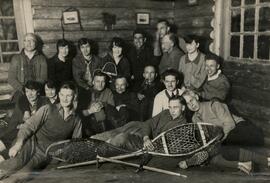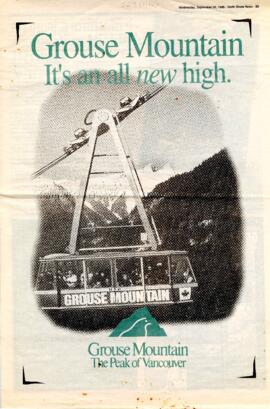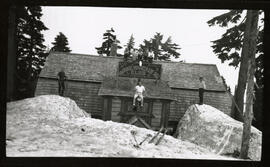This is a good, short little breakdown of the main attempts on the Mount Garibaldi peaks.
Alpine Club of Canada - Vancouver SectionSometimes, the handwritten and scribbled notes of yesteryear are very intriguing. This list appears to be the BC Mountaineering Club members' attempts on Mount Garibaldi in the years of their exploration, though there is not enough information to confirm this.
British Columbia Mountaineering ClubThis photo was noted as the "1st ascent, Brunswick" on Labour Day, 1909. This mountain is close to Lions Bay, BC. The background shows the Sky Pilot Massif to their left. Who the mountaineers are is unknown, though it can be imagined that they are very much enjoying the view.
Charles ChapmanWhile many mountaineers sought friendship and camaraderie in clubs and on group outings, others sought the solitude of mountains.
John Clarke was one of those mountaineers. Unexperienced as he joined his first ski expedition, John became a skilled mountaineer who would spend weeks at a time on his own, trekking through valleys and over peaks.
Hooked on the “dream state” of “floating in the landscape” after leaving city life behind, John claimed more than eight hundred first recorded ascents.
After witnessing the death of a friend in an avalanche, John hung up his boots and instead focused on educating youth on our fragile landscape.
Alice Purdey climbing in 1968. Location unknown.
Unlike earlier mountaineers, she is carrying more advanced equipment that is known as a rack. By carrying more gear that is more specialized, this made her climb a safer experience. This would have allowed her to attempt more difficult climbs while maintaining a reasonable level of safety.
A photo of Alpha and Serratus from Zenith Ridge, in the Tantalus Range. The photo is part of a photo album of the Garibaldi area that was made by Neal Carter.
Neal CarterWhy hike from the valley floor when you can drive as far as you can? While early mountaineers on Mount Garibaldi had to hike on foot or ride horses, the building of forest service roads — or in this case a road to a planned ski development — made it easier to get to more distant trails.
Here, the BC Mountaineering Club take a day trip to Mount Garibaldi in 1979, taking their cars as far as they could up to Brohm Ridge.
Michael Charles FellerPlease Note: This video contains the story of an avalanche that injured two of the mountaineering party and includes photos of head wounds.
In the 1960s, Alice Purdey was a leader of the pack, being one of Canada's best climbers. In 1967, Alice and four fellow climbers set out to attempt the unclimbed north ridge of Mount Logan. Unlike many successful ascents, this expedition did not succeed.
An avalanche caught two of the party, leaving Alice among the rescue group and practicing her recently-learned skin-stitching skills. Thankfully the whole group made it out safely.
In this short video, Alice Purdey recounts that memorable expedition.
Archives of North VancouverHere, the North Shore Rescue group conduct avalanche probe training on Seymour Mountain, circa 1983. Training such as this was important for the group given the popularity of back country adventures in winter.
North Shore RescueWhile the snowshoe equipment and clothing may be different, the joy of stopping on route for a cup of warm tea must be the same as today. But whereas most people nowadays would carry a Thermos flask, this group had a campfire and kettle.
Depicted in this photograph are Mrs. W. Johnson, Edith Henby, Phyllis and Don Munday, Millie Dodds, and Neal Carter.
Percie LockieHugh Aikens had many memories of his time in the North Shore Mountains, hiking and skiing around the 1940s and 1950s. This included his time on Seymour Mountain, on the slopes and in the cabins.
He skied on Seymour at the time that Vancouverites were building many of the cabins, giving insight into cabin life in the middle of the twentieth century.
British Columbia Mountaineering ClubWhen the BC Mountaineering Club headed for a camp at Lake Louise Station, Alberta, in 1958, they did not skimp on their order. Fifty pounds of bacon, three types of jam, ten pounds of coffee, four pounds of icing sugar...they must have needed a truck just for supplies. Assuming it was for one single expedition, this order gives an interesting insight into the food and supplies taken with them.
British Columbia Mountaineering ClubThere were no ultralight and snug tents for the early mountaineers, as this photo from a BC Mountaineering Club camp in August 1924 shows. Today, tents for mountaineers may only hold a couple of people. In this photo though, the "men's tent" in the background would have slept a bigger group than is normal today.
Materials have also changed over the years. Whereas today, synthetic materials are lightweight and waterproof, it was probably a type of waxed canvas that mountaineers slept under. This kind of fabric would have been fairly heavy to transport. Did the mountaineers perhaps yearn for something lighter?
What is similar though is the communal eating area. The "cook tent and dining fly" seen here in the foreground is similar to expeditions today where mountaineers establish camp for a week or more.
British Columbia Mountaineering ClubIf there were such a thing as Instagram in the 1920s, this would perhaps have been one for a post. Here, an unnamed mountaineer poses while on a BC Mountaineering Club Camp at Singing Creek, near Cheakamus Lake, in August 1924.
British Columbia Mountaineering ClubLooking at ease on a mountain face, BC Mountaineering Club members and “the first rope lunchtime, below "K.M." Pinnacle, August 1924”.
British Columbia Mountaineering ClubNearly there — but there is not much room on the summit for the third climber. This incredible photo shows three BC Mountaineering Club members on the north ridge of Mount Tantalus in 1974.
At around 2600 metres, the view looking east towards Black Tusk would have been incredible.
Michael Charles FellerInterested in “The Mummery” or “The Whymper” tent for camping? Or “High Grade Climbing Boots” for seven dollars?
While the earliest years of mountain exploration were very limited for clothing, equipment and supplies, later decades saw the birth of an industry of outdoor-specific gear.
This 1958 catalogue of tents and camp equipment gives a fascinating insight into everything that was available to the hiker, climber, camper or explorer in the middle of the twentieth century.
British Columbia Mountaineering Club"Bill Dobson leading the way out onto Garibaldi Lake, Jack Sutherland roped in the middle and Jim Irving taking the pictures as we explored. Easter week 1928."
Joyce Coats and husband George built a cabin on Mount Seymour between 1953 and 1956. There was a two-year hiatus in the construction while George attended business school.
This photo, probably taken around 1955-1956 shows the partially completed cabin. They collected lumber from trees felled nearby. The steel beams in the roof were dragged by sled up the mountainside during winter. The beams were George’s idea. He was a civil engineer (though not certified at the time) and designed the structure. All the windows and furnishings were taken by foot to the cabin during summer.
A home-from-home on the mountain — or as homely as it could be, given that everything had to be carried in by muscle power.
In this photo, Joyce Coates relaxes in the cabin she and husband George had built. The size of the kettle on the stove is huge. It would have done a good job in making tea for a party of skiers or filling a sink with hot water for washing dishes to make up for a lack of running water.
A year after this photo was taken in 1959, she and George moved to Montreal and donated the cabin to the Boy Scouts of Canada.
Described only as "camp" in 1914, it is likely to be one of the BC Mountaineering Club summer expeditions to the Garibaldi area. With the rope and their ice axes, these women look set for a day's trek, maybe across a glacier.
Charles ChapmanA photo of Castle Towers to Carr Mountain from Red Mountain in the Garibaldi Range. The photo is part of a photo album by Neal Carter of the Garibaldi area.
Neal CarterTaken in 1956 on Mount Seymour, Joyce Coates stands in front of the cabin she built with her husband George. A home-from-home, the cabin gave them more time to ski in winter, and a place to relax in summer — that was after they finished building it. They had spent the summer of 1956 living on the mountain during its construction.
When the snow came deep in winter, their sense of accomplishment must have been great.
Joyce Coates pauses while skiing in 1956 on Mount Seymour. No doubt she was enjoying the view. As a skier who had a cabin on Mount Seymour, she had more time to enjoy such ski outings than those who had to trek up the mountain each day.
This photo is described as “Conquerors of the Eastern Lion” in 1908. This party may have reached the summit, but they were not the first as it was first scaled by John Latta and his two brothers in 1903.
The concept of "conquering" mountains is now understood to be a uniquely colonial attitude. A part of our interconnected world, mountains are not there to be "overcome" as in the definition of conquering. In addition, the settlers who claimed "first ascent" of a mountain were in fact claiming the first recorded ascent under the settler construct of "peak bagging". Being on the territorial lands of Indigenous Nations, wherever they were in BC, those settlers were quite possibly following in the footsteps of many Indigenous individuals who were hunting, gathering or traversing the mountains for other reasons.
Charles ChapmanWhen European settlers first explored the North Shore Mountains, they had no maps. Creating their own surveys and making their own maps formed part of their expeditions.
This beautiful hand-drawn map of the backcountry area north of Indian Arm and Coquitlam Lake was made by Neal Carter and is one of the first paper maps of the area — or perhaps even the very first. The map is part of a photo album he made showing peaks of the area. Attached to the map is a 2 page account by Nellie Fraser of expeditions of Coquitlam Mtn. by ACC members.
Neal CarterPlease Note: This report includes the term "Indian” which is no longer acceptable as it does not reflect the sovereign status of Indigenous Nations and the cultural differences among them.
The Garibaldi area was the fourth park established in British Columbia. Today around eighty thousand visitors per year enjoy the views, likely without thinking about how it came to be.
This 1984 report gives a detailed and interesting look at the story of the park, including the activities of the BC Mountaineering Club, its members and the evolution of park access and infrastructure.
Katie BellPreventing the need for rescue was important to the North Shore Rescue team. Here, Earl Chambers gives a hiking safety lecture to students on Grouse Mountain in 1970. That prevention education is still a part of the team’s work today.
North Shore RescueAs the BC Mountaineering Club's longest serving trip director, Tom Fyles must have had many stories to tell. A gifted climber, he took on many challenging routes, claiming many first recorded ascents in the process. Not content with his own climbs, he inspired many other mountaineers over the years.
This short video puts a spotlight on this popular and talented mountaineer.
As part of the strategy to prevent rescues in the first place, the North Shore Rescue team was responsible for trail management. This included marking and cutting trails.
Here, the team marks the trail from Seymour Mountain to Elsey Lake. This route was important to work on as Elsey Lake had a hut that hikers would try to reach but get into difficulty on the way.
North Shore RescueEstelle Rose (Gilbert) on skis. Year and location unknown.
British Columbia Mountaineering ClubPlease Note: This audio interview includes the term "Indian” which is no longer acceptable as it does not reflect the sovereign status of Indigenous Nations and the cultural differences among them.
When you climb so many mountains, memories of the treks must be interwoven with each other — which peaks you climbed, who you were with, the sights you saw, or the things that went right, or wrong.
Here, Dick Chambers recounts some of his memories from the 1950s climbing in the Garibaldi and Tantalus ranges.
Dick ChambersFor those who know the fun of skiing or tobogganing today, watching this footage from decades ago will be very familiar. Families and friends out enjoying the slopes on a sunny day. Even the queue for the rope tow to get back upslope might be familiar to some.
This video also lets us see what winter fun on Mount Seymour in the earlier years was like. It even includes footage of a ski jump competition. What is interesting, or perhaps terrifying, is that the ski jump ramp seems to have no barriers to stop a competitor flying off in the wrong direction.
Mount Tantalus may not be as famous as its neighbour Mount Garibaldi but it is almost as high. Mount Tantalus is only about sixty metres shorter. This makes climbing it just as impressive.
Here, Basil Darling is on the first recorded ascent of the peak, with a second unnamed man behind him. The second climber would have been his climbing partner Alan Morkill or J. Davies, with the photographer being the other partner. All three men recorded that first ascent.
Despite their elevation in the photo, the men look at ease on the climb.
Neal CarterA group of men and women mountaineers on the first recorded ascent of Fitzsimmons Peak, near Whistler, in 1924. What the photo does not show is that this peak is 2600 metres (~8500 feet) in elevation, making in impressive achievement.
Today, Mount Seymour is a half day's hike from the parking lot at the Seymour Ski Resort. Popular with families, it is a very different experience from the first recorded ascent by Charles Chapman in 1908.
On the way, Charles and his climbing buddies spotted a tree stump that looked like a water pump. Nicknaming it Pump Peak, the name stuck. Over a century later, this summit on the way to Mount Seymour is still called Pump Peak.
This short video follows Charles' grandchildren as they make the journey to the summit in honour of that 1908 ascent.
Archives of North VancouverAccording to item F205-S12(12-6)-i1, the first float plane landed on Garibaldi Lake in 1930 or 1931. This plane was possibly taking people and supplies for camp or Park needs. After years of trekking everything into the area by horseback, a plane was a much easier way to get to this lake that sits at an elevation of almost 1500 metres (~4500 feet).
British Columbia Mountaineering ClubMountaineers have to be tenacious. Not only must they keep physically clinging to the equipment, or the rock and ice that keeps them from falling, but they also have to keep going even when their route is blocked, or their plans change.
In this video, Martin and Esther Kafer, along with friend Dave Boyd, show just want tenacity is, as they climb to the summit of Mount Monarch at over 3500 metres (over 11,500 feet).
Martin KaferThis group photo was taken at the 1913 Garibaldi Camp, held by the BC Mountaineering Club.
These folks were serious about their outdoor adventures, but without clothing designed for camping or climbing in the alpine and subalpine, they had to make do with their regular clothes.
Charles ChapmanThe party of mountaineers on route to Squamish (known as Newport at the time) “on the Britannia” for an attempt at reaching the summit of Mount Garibaldi. In the party were A. King, Arthur Tinniswood Dalton, William Tinniswood Dalton, G. B. Warren (back), James John Trorey (middle), and T. Pattison (front). Taken in 1907.
This expedition followed trips in earlier years to make an attempt on the summit.
British Columbia Mountaineering ClubGaribaldi Lake is at an elevation of almost 1500 metres (~4500 feet). Yet this timeline tells us that in 1928 the lake was stocked with fish. That begs the question, how were the fish taken there? Were they taken by horseback, cocooned in a swishing, sloshing saddle pack? Or were they air-dropped by a plane that never landed, as has been the practice elsewhere and in later years?
This document does not say why or how the fish-stocking happened. However, this short timeline is a very useful breakdown of the history of Garibaldi Park before 1942.
British Columbia Mountaineering ClubEarly settler mountaineers fell in love with the Garibaldi area. Their passion for this special place led them to advocate for its protection.
This love for the area is clear to see in the photo albums of Neal Carter, an early BC mountaineer. These pages are an extract from expeditions to the Garibaldi region. The care and attention he has put into these pages suggests just how much the mountains meant to him.
Neal CarterGertrude Wepsala was a ski champion. Her most notable win was the ladies' downhill slalom in the March 1940 Dominion Championships. Thanks to the banner in this photo, it would suggest that this was one of her winning runs. Well done Gertie!
Gertie Beaton (nee Wepsala)Gertrude Wepsala pets a St Bernard dog. Location unknown.
The love affair between early settler adventurers and the Mount Garibaldi region was strong. Being among the few settlers who knew the area, their desire to preserve it to share with others led to their advocacy for Park status.
This article in the British Columbia Monthly magazine in 1919 is an eloquent description of the area and the place it had in the hearts of those who knew it.
In 1920 it became the Garibaldi Park Reserve, before becoming Garibaldi Provincial Park in 1927.
British Columbia Mountaineering ClubThe peak these "mountaineers" have climbed is unknown, but it does look to be fairly high and exposed. Taken in 1910, the men look more dressed for a picnic than hiking or mountaineering. But they all look like they have taken this climb in their stride.
Charles ChapmanThe smiles say it all — a get together in the Grouse Mountain Cabin. Who could ask for more?
Their hobnail boots, seen here, would have been helpful in getting to the cabin. These boots gave traction while walking on ice or scrambling up steep snow. Those snowshoes would have been essential for getting across deeper snow. The snowshoes and ice axes in front have been arranged to represent the BC Mountaineering Club crest. Taken between 1930-1949.
British Columbia Mountaineering ClubWhen Grouse Mountain had a grand reopening in 1996, there was a special pullout in the North Shore News. With a touch of nostalgia, the piece looks back at the early years of the resort — including Al Beaton's tale of drunken dignitaries on the 1948 opening day of the original chairlift (that travelled up the mountain from near the top of Lonsdale Avenue).
Spending around $15 on bamboo poles, boots, cable bindings and skis made of ash wood was a lot of money for James Adam Craig’s mother. At the time she bought them, around 1940, it would have been similar to spending roughly $270 today. And James did not even like skiing. But, as this article shows, his time spent on Grouse Mountain with friends has stuck with him for decades.
His memories of the 1940s are detailed, giving us a glimpse into his time building cabins and socializing in them, even skipping off work to help with construction, and the effort involved just to get to the slopes.
He also gives a good account of ski equipment of the time.
James Adam CraigGrouse Mountain Ski Club cabin. How many friendships were cemented here? How many trips were planned or successful ones celebrated? If only the cabin could talk, it would have had many stories to tell.
L. to R: D. Manley, V. Poulter (?), N. Nelsen (?)

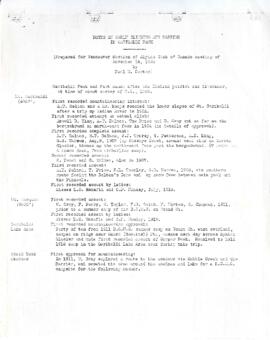
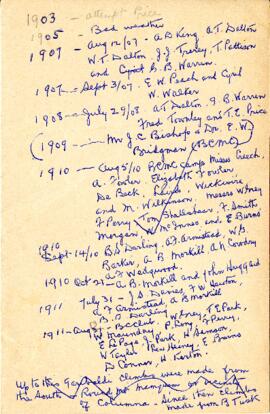
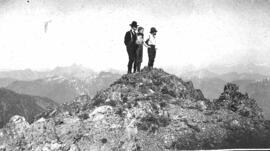
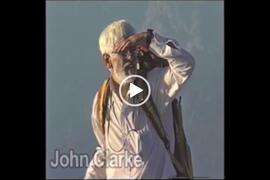
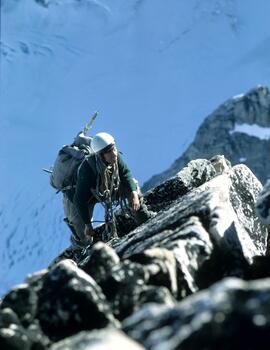
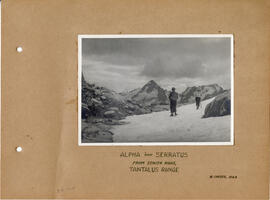
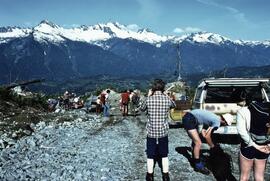
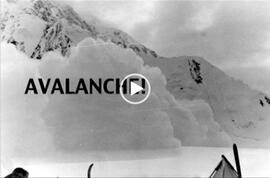
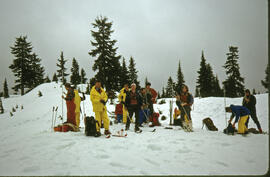
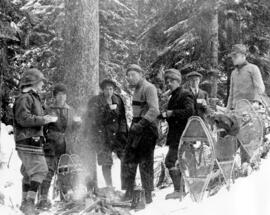

![[B.C. Mountaineering Club Order List from Woodward Stores Limited]](/uploads/r/passion-for-adventure/5/1/d/51d9929ab6da77394919842f649d0d34873526cb4c493e0dfe804147cc3db9d0/F205-S11_12-2_-i2_142.jpg)
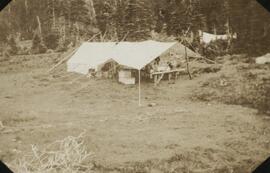
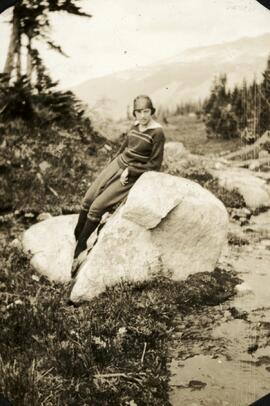
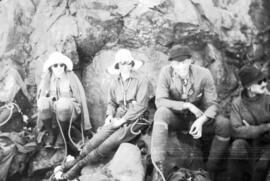

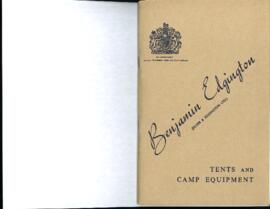
![[Bill Dobson and Jack Sutherland on Garibaldi Lake, Easter week 1928.]](/uploads/r/passion-for-adventure/b/0/0/b00721daa5ce2767407294e77e8206c3642491e9d7124a67f74ba464fcafe4cf/F205-8.009_142.jpg)

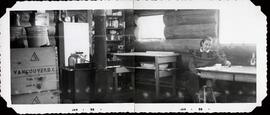
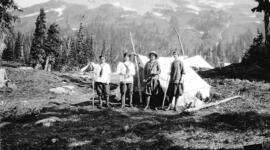

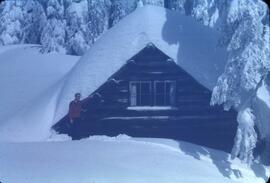
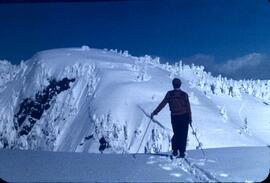
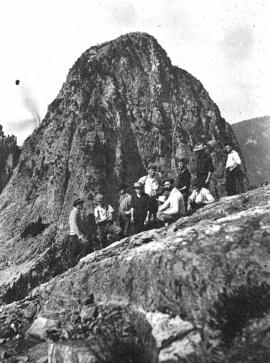
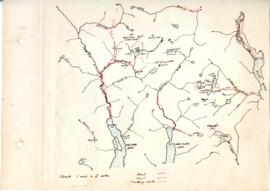
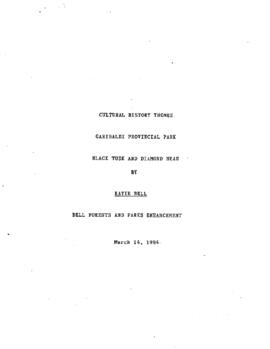
![[Earl Chambers Giving a Hiking Safety Lecture on Grouse Mt.]](/uploads/r/passion-for-adventure/1/f/5/1f5b7f82c027f6c1e30c0c1738a365708c84c9b57e8c260812723ccf7366f53e/NSR-34_142.jpg)
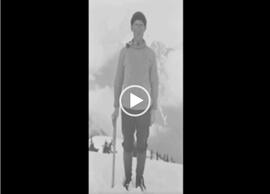

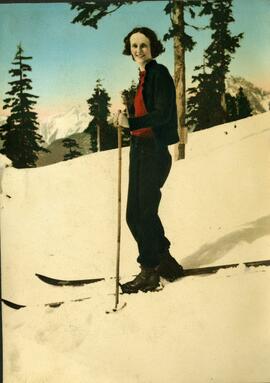
![[Excerpt from Dick Chambers April 1997 Interview]](/uploads/r/passion-for-adventure/b/d/6/bd6b59d96ab426d7bfad4e8a2d6406d740938c231376f7eb403ddac7ad471384/F205-S22-DC.jpg)
![[Excerpt from Fromme 8mm Film Reel 2 - Skiing on Mount Seymour]](/uploads/r/passion-for-adventure/e/7/7/e77e5e71a1666e57997fea95b048664162eba37d06c06ccbd633e8beda40f2f5/Fromme_Family_Reel.jpg)
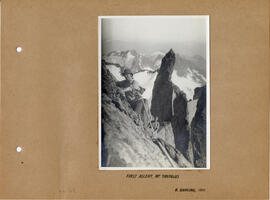
!["First Ascent [Fitzsimmons Peak], 1924"](/uploads/r/passion-for-adventure/1/a/f/1af2ad6843a10f07b8d6e4841cd31ecd53010276ddc9acbb0dca1906fe2b9a74/F205-12.153_142.jpg)
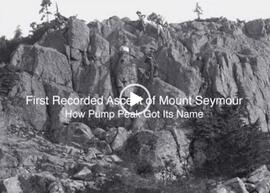
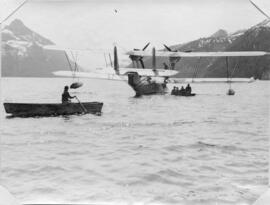

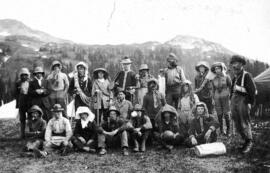
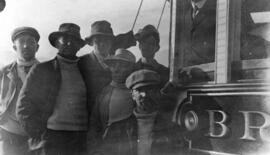


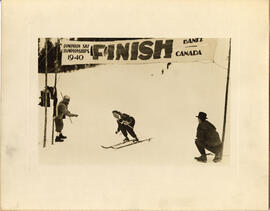
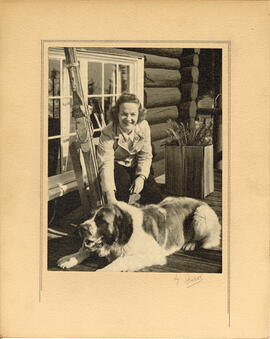

![[Group of Mountaineers on Peak]](/uploads/r/passion-for-adventure/9/8/7/987cc0e11602bc0ba8d31423e803ee180405184d987ead862c8a104544f462bd/F205-64-047_142.jpg)
